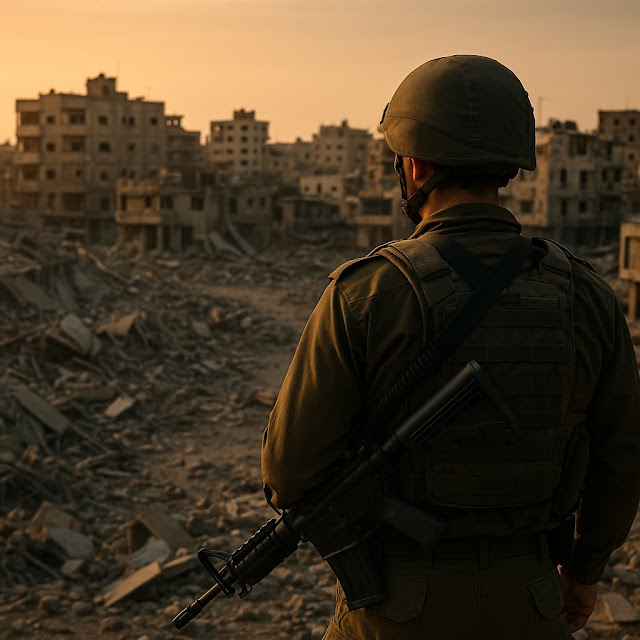
Introduction
Israel’s Defence Minister, Israel Katz, has declared that Israeli forces will continue to occupy key “security zones” within Gaza even after the current military conflict subsides. These zones, seized as part of Israel’s military operations, are designed to serve as protective buffers around Israeli communities.
Katz stated that "tens of percent" of Gaza territory has already been added to these buffer zones since the conflict reignited three weeks ago. He emphasised the necessity of these areas for national security, citing similar tactics employed in Lebanon and Syria.
Meanwhile, humanitarian organisations are raising alarm over the escalating toll of Israel's military campaign. Médecins Sans Frontières (MSF) issued a stark warning, calling Gaza a "mass grave" for civilians and aid workers alike. Amande Bazerolle, MSF’s emergency coordinator in Gaza, said, “We are witnessing the real-time destruction and displacement of an entire population.
Mounting Civilian Casualties and Displacement
Gaza’s health ministry reports over 1,650 fatalities since the fighting resumed on 18 March, including 24 Palestinians killed in Israeli airstrikes on Wednesday alone. Among the victims were 10 members of the Hassouna family, mostly women and children. One, Fatema Hassouna, was a young writer and photographer.
The UN now estimates that nearly 70% of Gaza lies within active Israeli military evacuation zones. These zones include “no-go” areas along borders with Israel and Egypt as well as areas around Wadi Gaza. An estimated 500,000 people have been displaced again, many with nowhere safe to turn.
The Israel Defense Forces (IDF) claims to have eliminated hundreds of militants while progressing across northern and southern regions. A new military corridor has also been established to separate Rafah from Khan Younis, designating nearly 30% of Gaza as an “operational security perimeter.”
Ongoing Hostage Crisis and Blockade
Katz reiterated that the hostage crisis remains Israel's top priority and that the military will not retreat from captured zones. “The IDF will not evacuate areas that have been cleared. These zones are vital buffers to protect Israeli communities under any future scenario,” he stated.
However, the Hostages and Missing Families Forum, representing relatives of abducted Israelis, sharply criticised the strategy, calling it an “illusion” that prioritises land seizure over saving lives.
“There’s one practical solution: release all the hostages at once in exchange for ending the war,” the forum declared.
Meanwhile, Israeli veterans and reservists are increasingly vocal, publishing open letters urging leaders to prioritise the hostages' return over continued military operations.
Katz also confirmed the continuation of Israel’s full blockade of Gaza, which began on 2 March—halting all entry of food, medicine, and essential aid. He described the blockade as a “pressure tool” to force Hamas into releasing the remaining hostages.
Humanitarian Crisis Deepens
UN agencies and humanitarian organisations are pushing back hard. Despite claims by Israeli officials that 25,000 aid lorries entered Gaza during the last ceasefire, aid workers say critical shortages persist. The UN warns the blockade may violate international humanitarian law.
Among the gravest concerns:
Tents for shelter are depleted
Malnutrition rates among children are surging
Access to healthcare is collapsing
MSF confirmed that two staff members have been killed recently, and accused Israeli forces of showing a “complete disregard” for medical workers. The charity also reports dire shortages of pain medications, antibiotics, and surgical supplies.
Background to the Conflict
This renewed conflict stems from the 7 October 2023 Hamas attack, which resulted in 1,200 Israeli deaths and 251 hostages being taken. Since then, Gaza’s health ministry reports that over 51,000 people have been killed in Israeli strikes.
During a brief ceasefire starting on 19 January, Hamas released 33 hostages—eight of whom were dead—in exchange for the release of 1,900 Palestinian prisoners and the entry of humanitarian aid.
However, the ceasefire collapsed when Hamas rejected a proposal to extend the deal in exchange for freeing more hostages. Israel accused Hamas of breaking the agreement, while Hamas insisted Israel had failed to honour the terms of a broader peace framework.
Ongoing Negotiations and Tensions
Negotiations appear stalled. A senior Palestinian official told the BBC that Hamas rejected a new six-week ceasefire plan in exchange for releasing half of the remaining hostages and surrendering arms. Israel claims it has not yet received a formal response.
Meanwhile, Palestinian Islamic Jihad released a new video showing Rom Braslavski, a 21-year-old Israeli-German hostage, pleading for help. Germany’s Ambassador to Israel, Steffen Seibert, responded with urgency, saying: “The terrorists must release him and all hostages now. There is no more urgent priority.”


Post a Comment